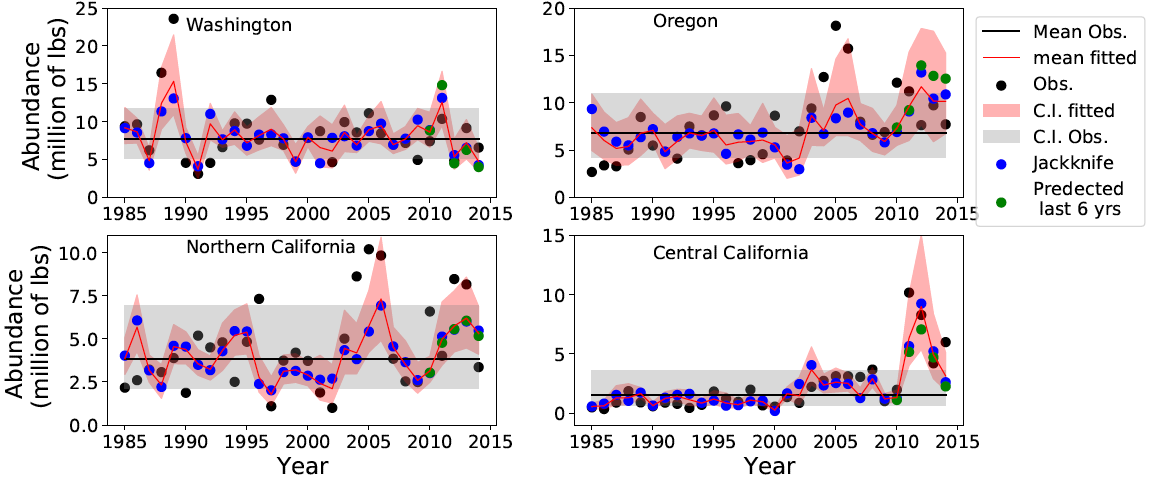Research
Ongoing projects:
I recently completed a postdoctoral scholar position with School of Aquatic and Fishery Sciences (SAFS), where I collaborated with Dr. Andre Punt, the Director of SAFS, and Dr. Dan Holland from NOAA on a project that aimed to develop predictive models for several West Coast fisheries. In this project, I utilized data on ocean temperature and circulation, which are critical drivers of species distribution and behavior. Through analyzing these data sets and constructing models that consider the intricate interplay between environmental variability and species life histories, I was able to generate predictions about the abundance and distribution of Dungeness crab and Pink shrimp across the U.S. West coast. These models can be used by fisheries managers and stakeholders to make more informed decisions concerning the management and conservation of these important species, as well as to better comprehend the broader environmental impacts on marine ecosystems.
Oceanographic drivers of legal-sized male Dungeness crab in the California Current System

I investigated environmental drivers of US West coast legal-sized male Dungeness crab (Cancer magister or Metacarcinus magister) with the goal of developing an environmental index that can inform the stock assessment on future recruitment. A conceptual life history approach is used to generate life-stage-specific and spatio-temporally specific mechanistic hypotheses regarding oceanographic variables that influence survival at each life stage. Linear models are fit using the pre-season abundance estimates of the coastal population of legal-sized male Dungeness crab from 1970 to 2016 (North and Central California) and from 1982-2016 (Oregon and Washington) as the dependent variable and environmental drivers from ROMS model outputs for the California Current System as the independent variables, with environmental predictors selected using model comparison techniques.
Past Projects:
Metapopulations dynamics, populations fluctuations, and stochastic dispersal

Fluctuating connectivity may not be the only mechanism behind populations’fluctuations. Three major hypothesis link pattern of population’ fluctuations to fluctuating environmental conditions, interactions among or/and between species, or/and to dispersal. While, These hypothesis have been studied alone or in pairs in order to understand contribution of each to population’ fluctuations. I study the effects of varying environmental conditions on dispersal, and how it affects metapopulation dynamics when considering species interactions.
Climate change and marine metapopulation: The dispersal mediated effects

With ongoing climate change, marine species with bipartite life cycle; a sedentary adult phase and larval pelagic phase, are subjected to effects that modify pelagic features such as larval duration as well as ocean currents. In this project, I considered the indirect effects of both abiotic ocean currents and temperature-prone larval duration to investigate the combined effects of climate change on both local mortality and regional dispersal and how they affect stability of marine metapopulations.
Marine protected areas network in a varrying environment: Where, how big and distant?

Principles for designing marine protected area (MPAs) networks that address social, economic, and biological criteria are well studied in the scientific literature. However, variability of environmental conditions and climate change represents a new and challenging issue to marine ecosystems functioning and stability. I revisit the problem of size and spacing in MPAs network using stochastic mathematical frameworks.
Old past Projects:
Projects concern modeling and time series analysis of some tropical vector-borne diseases such Lymphatic-filariasis (Wichereria bancrofti) and substance abuse such ahcohol and methamphetamine. In general, modeling of complex epidemiological systems is important as we try to understand the mechanisms that shape our environment and to develop reasonable response strategies
Influence of environmental factors on college alcohol drinking patterns
Modeling the transmission dynamics and control of lymphatic filariasis in Papua New Guinea
Burden of Chlamydia in the United States: Trend Analysis of Incidence Rates
